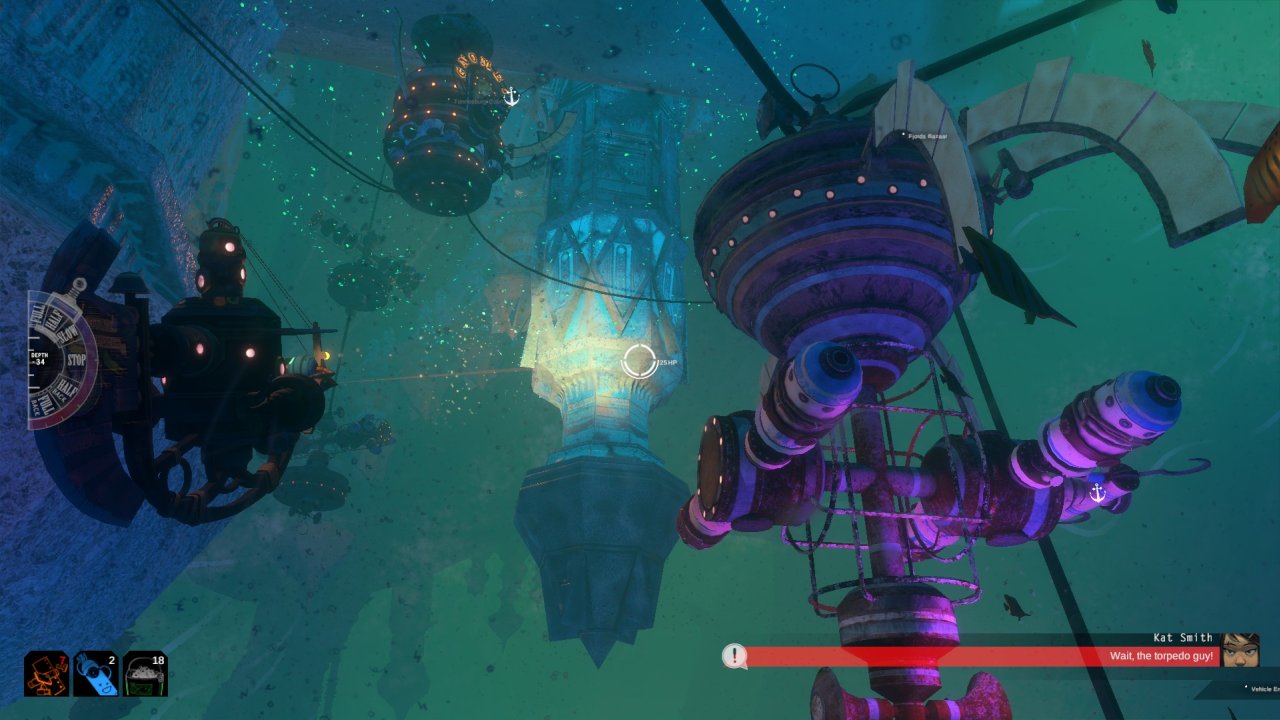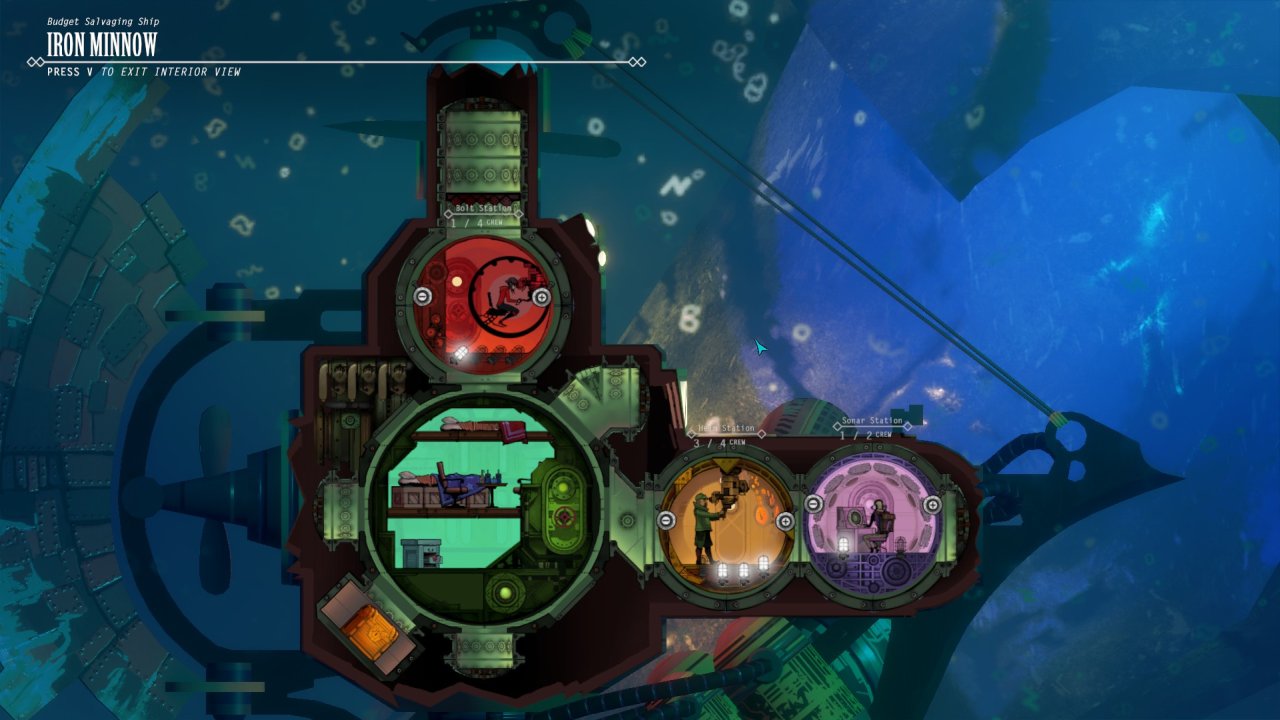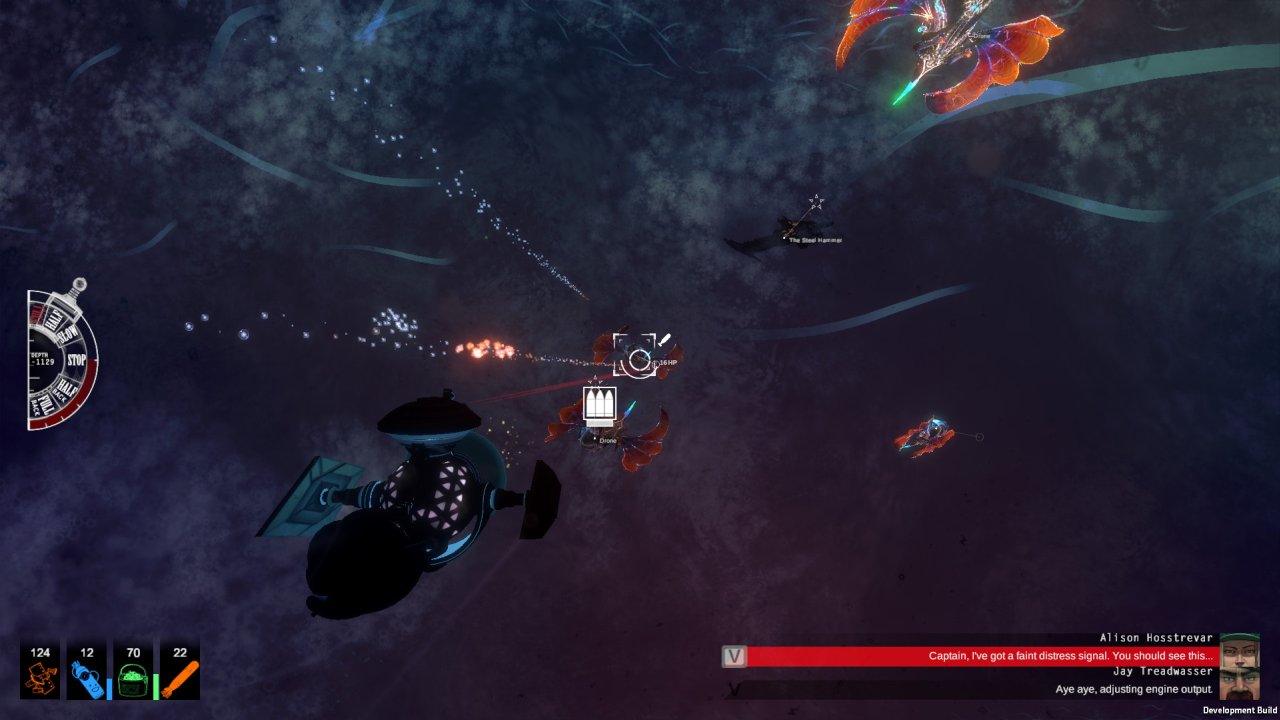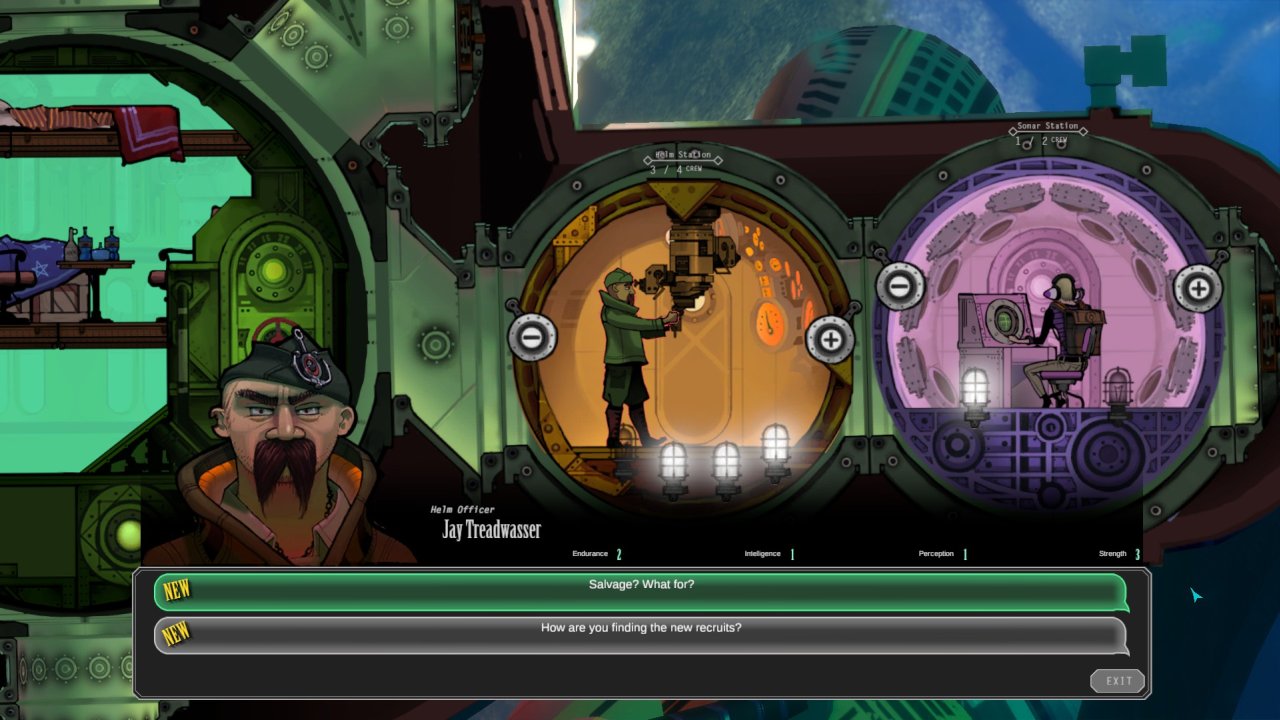Diluvion Review
Struggling in the shallows
The chief problem that space simulations seem to struggle with, once you get things like controls and background art out of the way, is that it’s kind of difficult to make space exciting to explore. It’s very big, as the Hitchhiker’s Guide to the Galaxy once eloquently noted, but what the Guide failed to point out is just how much of it is empty. Nothingness. Void. The interstellar gulf stretches in all directions on an incomprehensible scale, and you can drift for a very long time indeed without bumping into so much as a double yellow line. Now, the depths of the ocean, that’s the place to be; all the crushing oppressiveness of a hazardous working environment with considerably more interesting rock formations to accidentally ram your prow into. Everything’s a reasonable distance from everything else, there’s no hyperdrive to go wrong at a crucial moment, it’s always obvious which way is up, and nobody calls you out for dressing up like Napoleon Bonaparte while standing at the bridge. Sure, there aren’t as many exciting space monsters to blast out of the skies, but frankly most of the repulsive squishy things living on the ocean floor might as well be from another planet anyway, so what the heck, right?

It was with this mindset that I dived into... I mean, descended into Diluvion, a submarining adventure of exploration, navigation, crew management, and—when the need arises—ships firing lumps of scrap metal against one another until somebody springs a leak. A tragedy of vaguely mythological note has flooded the world and sealed humanity beneath the waves with a roof of impenetrable ice, forcing those who survived this event to live out their lives in scattered underwater settlements of moderate-to-miserable condition. You are the captain of a scrappy little relatively-unthreatening vessel of unknown origins, and you’ve taken it upon yourself to find the legendary artefact said to have the mystical power to neatly clean up this whole pickle, hidden on the deepest, darkest part of the ocean floor.
What I like about this setup is that it very clearly establishes both your long-term goal and the short-term goals that’ll lead to it. You have to go deeper. Except you can’t, because if you dive too far in that rust-bucket then it’ll be crushed under the mounting pressure like a Pepsi can ‘neath a troubled youth’s skate shoe. You’ll need a bigger boat—a goal that sounds all the more attractive after your first few scuffles with pirates—and you’ll need some idea of where to start looking. Oh yes, and once you take a peek down some of the more foreboding-looking crevasses, you’ll probably want to come back with some bigger guns, too. It all flows together very naturally, gating the world in such a way that mysteries lurk in the shadows beneath your feet, tantalisingly out of reach until you can get your hands on a hull that’s not thinner than the skin off an MRA’s nose.
Regardless, what you’re largely going to be doing is piloting. Or driving. Or captain-ing. One of those verbs, I’m sure of it. Controlling your sub is a right old doddle, which—depending on whether you’re the kind of person who likes to plant their face in the unending grittiness of the likes of Silent Hunter—is either a relief or a tremendous disappointment, but that doesn’t mean there’s no work involved in getting from A to B. Navigation plays a major role, and you certainly don’t have a dashboard of space-age positioning systems at your disposal. Your two best friends are your compass and your map of the area, the latter of which you won’t even have access to until you’ve managed to loot one from a seafarer’s sodden pack. I rather like it, to be honest; we’ve gotten so used to minimaps and waypoints being a staple of open-world design that people seem to forget that finding your way home can be rewarding in itself. Diluvion’s use of landmarks seems sort of self-defeating, though; they’re introduced as recognisable features of the underwater landscape that you can use to better pinpoint your position, but once you’ve visited one it also gets permanently added to the edges of your compass, letting you lazily home in on it from pretty much anywhere. I suppose the idea here is that the game gives you crutches once you’ve proved you can get around without them, but their presence feels like an unnecessary safety net, quashing the sense of adventure; a proverbial ball of yarn, trailing behind you in even the furthest reaches of the sea.

Not that I’m calling for an end to landmarks, mind; on the contrary, anything that makes the oceanic wilderness of Diluvion less dull to look at is fine by me. Being underwater, it’s understandable that you’re going to spend a lot more time peering into a murky, blue-tinged miasma rather than gazing at star-studded skyboxes, but even when you’re bobbing around in treacherous crevasses or scouring the bottom of the sea, a lot of the time it’s the same story: repeating textures, uninspired terrain, muddy lighting, and the faint lingering whiff of the clone tool. Things certainly get more atmospheric as you dive into the progressively darker, more sinister reaches of the ocean floor, but that’s more down to the coiling mists and the tiny spot of light coming from your headlamp, neither of which are much good when you bump into a cliff consisting of one flat, featureless material three hundred meters tall. Modelling an environment of this size is a pretty huge ask for an indie team, no questions about it, but that’s not much consolation when you’re bumbling around in another identical trench looking for copy-pasted shipwrecks to loot.
Turning our gaze inward, we’re reminded that the captain is first and foremost a team leader in a silly hat. On top of your core story-relevant ragtag crew, you can also hire and manage a given number of generic crew members, FTL-style, who can be assigned to buff various stations by an amount driven by their stats. A hulking musclebound sailor with biceps like basketballs, for example, is probably best off in the helm, shovelling coal into the boiler and boosting your top speed, while an additional wiry dork in the sonar chamber will reduce the time taken to charge your pings. It’s not a bad system for squeezing a modicum of extra performance out of your ship, but it doesn’t feel like quite as much of a central element as the game seems to think it is. You have the ability to juggle crew members around on the fly, of course—there’s even a slow-motion function specifically for getting it done in a hurry—but without all the shipboard intricacies of FTL I was mostly content to just stick peons where they worked best and leave them there for good. The only time you really need to move people at all is when the ship is about to come apart at the seams, but even then, the damage model is just hitpoints; all you do is shift everyone onto repair duty until your health is less dire, then put them back again.
All that handily brings us to the combat, which is… well, functional as a method of turning hostile subs into harmless floating junk, I suppose. You point and shoot. Some cannons are better than others, it’s harder to shoot while turning, and if you’re having a bit of trouble you can try booting a torpedo out the airlock, but by and large the entire system feels very bare-bones. Flying around in a loop and clicking on the little circle that tells you where to lead your shots has never exactly been the most engaging combat scenario, but usually it gets dressed up with an exciting arsenal, or breakneck speed, or a concentrated barrage of particle effects directly into your poor, frazzled optic nerve. Diluvion just sort of gives a nonplussed shrug. Simplistic mechanics don’t necessarily make combat bad, but they do make it wholly reliant on the encounter design. Sometimes that means pitched battles with a reanimated monstrosity from the sea floor; most of the time that means driving around in circles shooting at another hopelessly outmatched pirate who doesn’t know when to quit.

So much of Diluvion feels unevenly distributed like this: spread paper-thin in most places, genuinely great elsewhere. Even the dialogue, normally an excuse for writers to upend reams of their unedited work into the player’s screaming mouth, gives the impression of a script that went through a shredder and was subsequently reassembled from the strips that could be scavenged from the bottom of the wastepaper basket. I can appreciate staying lean, but often you’re supposed to talk to people to get a handle on what’s going on, and their terse one-line responses can leave a lot to be desired. Oh, I’m supposed to head to the drilling site? Don’t suppose you could elaborate on what they’re drilling, or where I’m supposed to find that, or why it’s important? No, no, I understand. I’ll just spend the next hour or so bumbling around blindly until I stumble upon a ruddy great big hole, shall I?
Whether or not you end up bumbling around, though, opportunistic salvaging is a key part of Diluvion’s experience, which is unfortunately not as exciting as it sounds. If you want money—and you do want money, because even the lousiest high-school-dropout crew member will put a serious dent in your dinars to hire—you’ll be stopping off at every shipwreck, abandoned settlement and picnic area you pass, and I can promise you that the game does not have the stamina to keep this experience fresh. There are FTL-style scripted events where you can risk a crew member for some extra supplies, or (if you have one to hand) use a special item to guarantee success, but after ten hours I’d seen precisely one scenario involving the same angry sailor, repeated ad nauseum, and those few drops of novelty had been gradually leached away. With the exception of occasional medallions that permanently upgrade crew member stats—magical artifacts hailing from, I don’t know, Poseidon’s piggy bank?—the overwhelming majority of what you scavenge is just ammo and bulk goods, to be carted back to the nearest merchant and dumped at the first opportunity. Nice of them to give us a roomy cargo hold, I suppose.
Of all the words in a reviewer’s arsenal, few are as erroneously deployed as “unfinished”. Most games are unfinished in one way or another; that’s just how development works. At best, it’s a meaningless statement, and at worst, it’s insinuating that a complete, functional product that you can play from start to finish simply isn’t enough to sate one’s bottomless consumerist demands. And yet… Diluvion keeps giving that impression, again and again. Basic systems without any garnish, wispy plot threads that don’t link up, the same crashed sub, copy-pasted over and over across the sea floor. There’s a real sense of roughness around the edges, too: checkpoints behaving inconsistently, framerates tanking out of nowhere on a regular basis, effects that look out of place or just downright ugly, and in the absence of reassuring feedback, the recurring spectre of fear that a logic flag somewhere along the line hasn’t quite clunked into place.

And that’s Diluvion in a nutshell, really: a fabulously ambitious indie submarine sim that’s been uncomfortably stretched and strained all over to make sure it covered all the bases. It’s a well-rounded blend of exploration, navigation, combat, and team management, but despite a myriad good ideas swilling around inside, none of it really feels polished or fleshed-out enough to excel. While it plays competently and has a few clever tricks hidden up its sleeve at times, the reality is clear: no matter how far you’ll dive, you’ll never find depth.
 Comments
Comments










